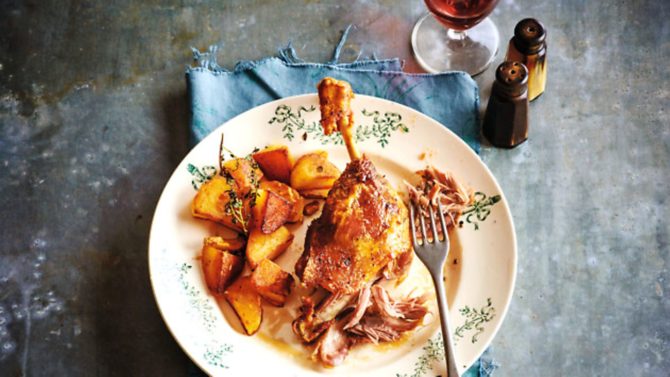Recipe for confit de canard

This classic dish from south-west France was designed to sustain locals during the cold winters months but it is now a dish found on most menus in this corner of France. Find out how to make your own confit de canard with this easy recipe
Originally from Gascony, a region renowned for the quality of its duck, confit de canard was designed to sustain locals during the cold winter months. Locally reared birds would be slaughtered at the end of summer and then salted, cooked and stored in fat to preserve them throughout the winter. This was a method introduced long before the days of refrigeration, and in fact the word confit is actually the past participle of the French verb, to preserve.
The meat is first salted which helps remove excess liquid before being roasted in duck or goose fat until meltingly tender (originally this would have taken many hours, perhaps all day). Once cold, the meat can either be stored in the set fat for up to six months, or nowadays refrigerated overnight and then reheated. As well as preserving food, this method also helps to tenderize the tougher cuts making it ideal for duck legs.
You will find duck confit on menus all over France, but in Gascony it is also traditionally incorporated into one of the region’s other famous dishes: cassoulet.
Although readily available in France in almost every supermarket, making duck confit at home is not only easy; it’s fun. It is a very simple process and to incorporate extra flavour, you can add various aromatics during both the salting and cooking process.
Once cooked, you must ensure that all the meat is totally covered by the hot fat before cooling and chilling. To reheat the duck, simply scrape away most of the fat and roast or pan-fry the duck legs to crisp up the skin. The remaining fat can be used to cook some potatoes, making it a very rich yet really economical dish.
RECIPE
INGREDIENTS
• 4 whole duck legs
• 3 tbsp sea salt
• 8 garlic cloves, peeled and bashed
• 2 small shallots, thinly sliced
• 4 sprigs fresh thyme, bashed
• 4 juniper berries, lightly bashed
• 1 tbsp freshly crushed black pepper
• 500-600g duck or goose fat
• 650g potatoes, peeled and cubed
METHOD
1. Wash and dry the duck legs, then rub salt into them. Scatter half of the garlic cloves, sliced shallots, thyme sprigs, juniper berries and pepper over the base of a ceramic dish. Top with the duck legs and scatter over the remaining aromatics. Cover the dish with cling film and refrigerate for 24 hours. Brush the duck legs to remove the salt and place in a high-sided baking dish to fit snugly. Reserve the garlic cloves and thyme.
2. Preheat the oven to 110°C/225°F. Melt the duck fat slowly in a saucepan until it is liquid and pour over the duck so that the legs are submerged. Cover with foil and roast for 3 hours or until the flesh feels really tender and almost falling from the bone. Remove from the oven and leave to go cold. Refrigerate until required.
3. To cook, preheat the oven to 200°C/400°F. Parboil the potatoes in a pan of boiling, salted water for 10 minutes, drain well. Scoop out about 4 tbsp of the set duck fat and heat in a frying pan, add the potatoes, some salt and the reserved garlic and thyme sprigs. Cook over medium heat, stirring occasionally for about 20 minutes until golden.
4. Meanwhile, remove the duck from the fat, with just a little still covering the meat and place on a rack set in a roasting tin. Roast for 20 minutes until crisp and heated through. Serve the duck and potatoes with some winter vegetables.
More French recipes: cassoulet; Daube de boeuf Provençale; tart Tatin
Share to: Facebook Twitter LinkedIn Email


